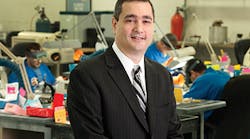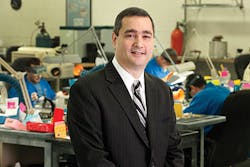by Steven Pigliacelli, MDT, CDT
A patient visits your office, and you determine through detailed exams and treatment planning that the person needs a full-mouth rehabilitation. Despite the clinical appropriateness of your treatment plan, the patient decides not to proceed with such extensive treatment due to financial reasons. Therefore you perform inadequate or greatly scaled-down treatment. In the long run, the patient will probably spend more money in repairs and redos, whereas if the case had been handled correctly from the start, both the patient and dentist would be satisfied.
One solution to this common and frustrating problem is "banking." Banking is a method in which the case is preplanned and prebilled from the start. It begins with a careful case plan and diagnostic models, setups, and surgical guides. After the consultation between the patient, surgeon or periodontist, restorative dentist, and lab, the final case design can be presented, a lab fee estimate can be supplied and a payment plan established. The total cost for all procedures will be given to the patient so he or she can begin paying before the surgery, and the patient will be required to pay until the bill is paid off.
When a payment plan is presented, similar to a plan for paying off a car or computer, a patient is often more willing and able to pay. Companies such as Dell Computer have managed to sell millions of computers based on a monthly budget concept of what the customer can afford per month, rather than people paying outright for their computers. Most orthodontists also bill in this manner and have done so for years.
The banking solution also works very well with the progressive loading model of restoration. Progressive loading is a popular concept now discussed at many seminars and clinics, but it has never been fully applied or appreciated, or even completely understood. It is a viable option that decreases the pressure on healing bone and soft tissue while giving implant fixtures additional time to fully osseointegrate. This provides patients with the convenience of a fixed prosthesis that gradually loads the implants. Progressive loading with a provisional restoration can be a viable treatment option for many implant cases both clinically and financially. Provisional restorations serve as diagnostic tools for determining final abutment selection and case design. With the provisional prosthesis as a model, a more esthetic and problem-free permanent prosthesis can be fabricated.
The progressive loading model offers many options for patients and dentists since there is more than one way to make a provisional and more than one design. Fiber mesh or cast-metal reinforced provisionals are often desirable because a few implants are placed and then activated by adding a temporary cylinder to connect to the implant, and they can be cold cured into the provisional. As time goes by, implants are activated and teeth are slowly removed until finally a fixed screw-retained or cemented provisional is completed. Another provisional design uses stud abutment such as Locators or ERAs. This is much like the previous provisional in that implants are placed slowly, but not all are activated until the final restoration is made. After all the implants are activated, the final case can be completed. In this scenario, anywhere from one to three years can be planned and budgeted for the final restoration.
The progressively loaded implant should be a standard to both load the implant and establish a budget for payment for the entire implant process. If patients know they can have a prosthesis that can be worn while the implants heal and the case is being made, and it can be kept as a spare in the event of a repair, they are more willing to accept the full restoration plan.
Furthermore, a payment system can be established for the final restorations at the time of the stent fabrication. The goal is to have the final cost estimate determined and a monthly payment plan devised to last from the provisional to the final insertion. When correctly timed out, the payments should be 75% done before construction of the final prosthesis. The beauty of this system is having the patient making scheduled payments prior to the completion of the case rather than after. If all is done according to plan, the patient should have only a small amount due when the prosthesis is completed.
Steven Pigliacelli, MDT, CDT, has more than 30 years' experience with Marotta Dental Studio as a dental implant specialist. Steven is an instructor in postgraduate prosthodontics at New York University, College of Dentistry. He manages Marotta Dental Studio and is the technical liaison between the dentist and lab for case planning, phone support, and quality control. Steven is president of the American Academy of Dental Prosthetic Technicians and the vice president of the Ethical Dental Laboratory Alliance. He has published in dental journals, and he lectures and performs hands-on demonstrations at study clubs and seminars.







